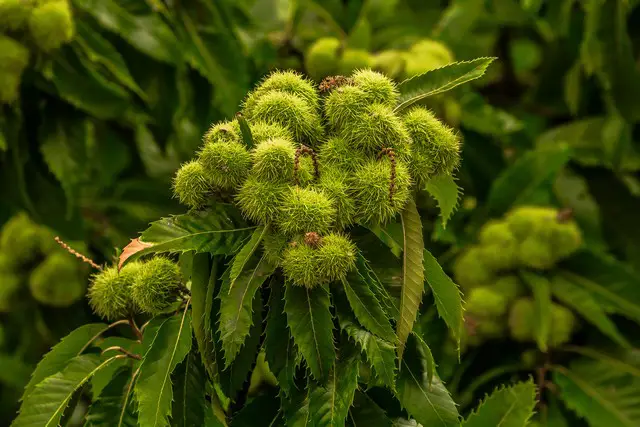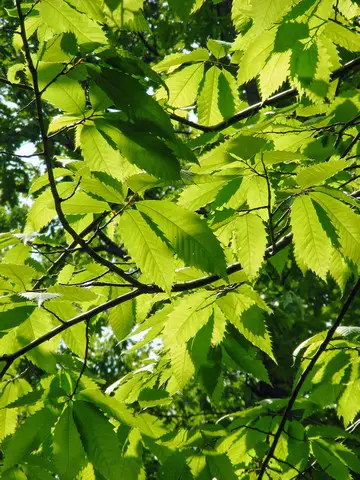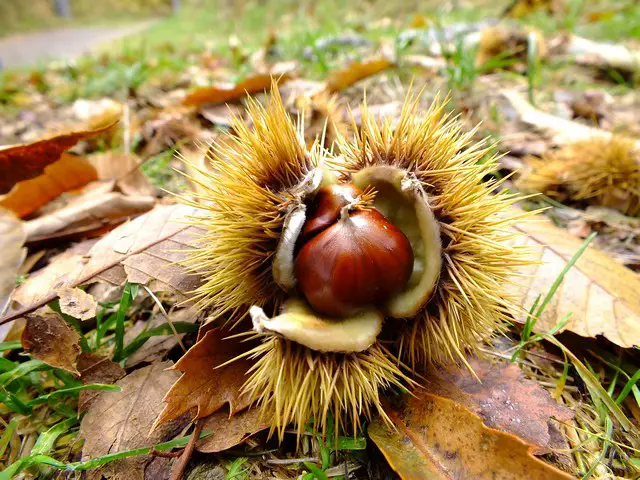Last Updated on November 24, 2021 by Grow with Bovees
Have you ever wondered why you can’t go foraging around Christmas time, and make your own ‘chestnuts roasting on an open fire’?
Chestnuts are available at supermarkets in the festive season, but it is extremely difficult to find your own in the wild.
To understand why, we need to look back at the history of these ancient trees.
Picture yourself on the East coast of North America, way back at the beginning of the 20th century, that is the 1900s. American chestnuts were everywhere!
Origins of the American Chestnut Tree (Castanea dentata)

The American chestnut comes from the Fagaceae family, so are cousins of beech trees and oak trees.
Don’t get the American chestnut confused with other trees such as the horsechestnut tree, which is a common chestnut tree, but it is smaller, and the nuts are sadly inedible.
It is estimated that in the 1800s there were up to 4 billion American chestnut trees in the wild.
In the eastern forests round the Appalachian mountains almost a quarter of all trees was the American chestnut.
It was an extremely common tree.
The American chestnut was once the dominant tree 100 years ago in the eastern United States, and these giant trees could reach over 100 feet tall.

Uses
The American chestnut tree isn’t just pretty to look at.
The straight grained wood from these prized trees was used in building log cabins and railroad ties in colonial times. However, chestnut lumber is no longer sold in the US.
The large serrated leaves were boiled and turned into medicine by Native Americans.
The catkin female and male flowers release a beautiful smell, and they become the famous chestnut, that is used in a variety of food and sweet treats.
It was the perfect tree!
What Tree Does a Chestnut Come From?
Yep, you’ve guessed it correctly!
It’s a chestnut tree.
There are several varieties of chestnut producing trees. Some chestnuts are edible, and taste really great when roasted over an open fire. The best thing to use for roasting chestnuts is a chestnut roaster, which is a large spoon-shaped metal piece at the end of a handle which you place your chestnuts on to hold over the fire.
Chestnut Blight
The downfall of the majestic American chestnuts was caused by a fungus called chestnut blight (Cryphonectria parasitica).
This blight fungus came to North America from Asia at the beginning of the 1900s.
It is native to Asia, but the blight spread attached to animal fur and bird feathers.
The spores to reproduce the fungus are released and travel in rain, and when trampled underfoot.
The first reported case of Cryphonectria parasitica, this lethal tree pathogen was in 1904 in the New York City New York City Bronx Zoo in Bronx Park.
Therefore, it is likely that the blight was introduced a few years before this. But by the 1950s it had caused near extinction of the Native chestnut tree!
Why is it so bad?
The fungus works by damaging the bark with small holes, eventually leading to tree death. We know that mature American chestnuts are more likely to get infected.
This could be because the forest canopy protects the infants from traveling spores.
This fungus mainly affects the mature American chestnut but can also affect European chestnut trees.
Trees are usually infected after they have reached 50 feet tall. Therefore, more immature trees are found in the eastern states.
When blight was first discovered, Americans were determined to save their native trees, so began to cut down infected chestnuts.
The instructions were to not leave not a ‘single bough’ of infected tree!
In fact, the root system of blighted trees remain even after they die, so they are not lost to us forever.
They can grow back through the stump sprouts, because only the above ground portion is killed by blight. Sadly, by the time they reach maturity they are usually infected.
American Chestnut Foundation Effort To Restore Species
Conservationists such as the American Chestnut Foundation are working to restore the populations of this species of American forest trees.
Scientists are experimenting to replicate an infectious virus which weakens and stops the blight. This could be used to protect future trees, and has worked in Europe already.
Some rot resistant strains remain, and their seeds are being collected.

Scientists are currently experimenting with crossing the resistant chestnut with Chinese chestnut trees.
This hybrid is then crossed back with the original American native trees to create a blight resistant American chestnut.
However, there is a concern that this could take a long time to reintroduce the native range back, and grow a new generation of trees. Estimates by different professionals are anywhere from 18-100 years!
Finally, researchers are working on finding the sequence of DNA for the American Chestnut and the blight to develop a genetically modified blight-resistant chestnut tree.
While this may seem like a tragic tale, time will tell whether this ancient species can be restored to their former glory.
In the meantime, maybe try foraging for more common trees such as black walnut trees instead!

